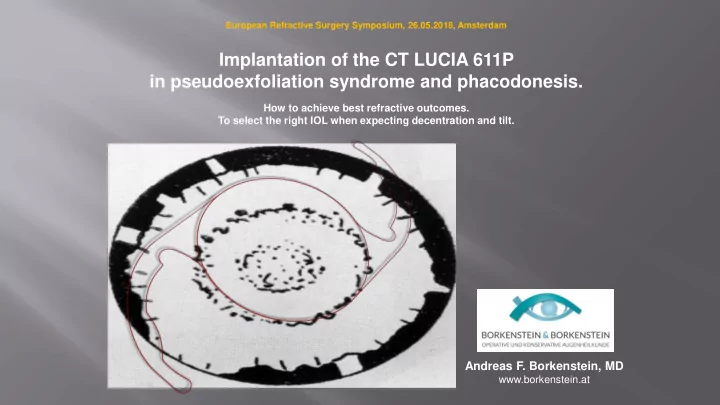

European Refractive Surgery Symposium, 26.05.2018, Amsterdam Implantation of the CT LUCIA 611P in pseudoexfoliation syndrome and phacodonesis. How to achieve best refractive outcomes. To select the right IOL when expecting decentration and tilt. Andreas F. Borkenstein, MD www.borkenstein.at
CT LUCIA 611P Specification made with ultra-high purity (Soxhlet extracted) hydrophobic acrylic and a proprietary cryo-lathing process. Overall 13 mm water content: 0.3% Optic 6 mm available both clear UV-blocking and with blue-light filtering (Yellow tinted 611PY) Material Hydrophobic no Glistenings Coating Heparin Diopter range +4 to +34 D (in 0.5 increments) Haptic Step Vaulted Aspheric design YES SA: -0.12µ Refractive index: 1.49 Abbe number: 51 Pre-loaded YES low refractive index + high Abbe number Blueject 2.0 – 2.4 Injector = low chromatic aberration and less dispersion 2.2mm – 2.6mm Incision size = IMPROVED QUALITY OF VISION Blue Light filter NO
Changes for imaging quality ZO (blue line) correct first some +SA of the cornea and then tend to be aberration neutral. Combining the advantages from negative SA and aberration-neutral lenses. This asphericity concept warrants a significantly reduced sensitivity against decentration and tilt. Enhances contrast sensitivity in mesopic conditions compared to spherical IOL. increased depth of focus compared to conventional aspheric IOLs.
Patient and surgeon satisfaction levels after using an acrylic, hydophobic, monofocal IOL and the Malyugin ring in pseudoexfoliation syndrome patients. Borkenstein AF, Borkenstein EM, Journal of Ophthalmology, ID 3843098, April 2018, accepted in press. 42 eyes were enrolled, main focus: satisfaction levels and OR workflow. Long-term clinical results and scanning electron microscopic analysis of the aspheric, hydrophobic, acrylic intraocular lens CT LUCIA 611P. Borkenstein AF, Borkenstein EM, Clinical Ophthalmology, ID 167895, May 2018, under review in press. 96 eyes were enrolled, target refraction, BCDVA and SEM analysis of the new design. Implantation of the CT LUCIA 611P in pseudoexfoliation syndrome and phacodonesis. A case series: Selecting the best IOL when expecting decentration and tilt.
Involvement of: lens, ciliary body and zonules Phacodonesis Subluxation of the lens Thinner PC, zonular rupture-vitreous loss IOL decentration and tilt Angle-closure glaucoma iris Pigment dispersion Poor / No mydriasis Capillary hemorrhages Increased aqueous flare Synechiae trabecular meshwork Open-angle/pxf glaucoma or hypertension Retinal vein occlusion cornea Endothelial decompensation and edema
CASE SERIES 15 eyes with PXF and phacodonesis were enrolled. Breaking the synechiae with OVD and spatula in 8 cases. Malyugin ring 6.25 and capsular tension ring was used in all cases. Phacoemulsification + implantation of the CT LUCIA 611P. Preoperative phacodonesis and weak zonules were examined in all cases (more or less distinctive). Main Question: Does the ZO optic and the new optic-haptic junction have any advantages in eyes with presumably IOL decentration and tilt?
center of cornea pupillary center center of the IOL Preliminary results: 5 months postoperatively (n=15) Pentacam: Myopic shifts evaluated (0/15 = 0.0%) Wavefront: Tilt and decentration measured (6/15 = 40.0%) Slit lamp: Phimosis and capsular shrinkage (3/15 = 20.0%) Primary posterior capsule fibrosis (2/15 = 13.3%) Glistenings (0/15 = 0.0%) IOL luxation (0/15 = 0.0%)
Pseudoexfoliation Eyes: Preliminary results: 5 months postoperatively (n=15) Subjective discomfort ( 0/15 = 0.0%) Halos or Glare ( 1/15 = 6.7%) Objective measured BCDVA >0.8 (decimal) (15/15 = 100%) Complicated cases – Pseudoexfoliation and Phacodonesis The intraoperative and postoperative performance of the IOL is crucial: implantation and unfolding process manipulation in the AC and impact on capsule/zonules visual performance and refractive stability IOL centration (decentration and tilt) PCO prevention Therefore most important for choosing the best monofocal IOL: “decentration and tilt forgiving” 1) optic optic-haptic junction, stability 2) design of the haptic
Based on our experience the new designed optic-haptic junction has shown improvements in: LUCIA 611P 1. centering in the capsular bag 2. rotational stability 3. refractive predictability 4. refractive stability 5. PCO prevention Enhanced square edge technology including the optic-haptic transition (= Achilles Heel of the IOL) with more thickness/stiffness to reduce growth of cells (PCO-prevention) and enhance stability. see published: Apple DJ, Borkenstein A et al, presented ASCRS 2010, Boston, USA. CT LUCIA 611P – optic-haptic junction-The Achilles Heel of the IOL; Borkenstein EM, Borkenstein AF, Graz, Austria.
Video CASE Implantation and Unfolding LUCIA 611P Male, 78y, Diabetes Hyperopic, Pseudoexfoliation Syndrome. Axis 22.43, AC 2.75, Malyugin ring 6.25
Therefore we can recommend the use of the fully preloaded Zeiss CT LUCIA 611P in complicated cases – PXF eyes: fast preparation of injector with enhanced OR workflow and easy to use. scrub nurse friendly small corneal incision – wound assisted implantation. cornea friendly gentle and smooth IOL insertion in the bag - no zonular stress. capsule and zonular friendly less surgical manipulation in small pupils and use of Malyugin ring. – iris contactless. iris friendly postoperative stability and “decentration/tilt - forgiving” (ZO optic). doc friendly hydrophobic acrylic with excellent BCDVA and without any glistenings. patient friendly
“Monofocal and Premium“ – no discrepancy! I´m choosing LUCIA in PXF eyes because: □ Easy to use - fully preloaded □ Good OR workflow □ Safe implantation in difficult eyes (small pupils, phacodonesis, Malyugin) □ Smooth unfolding process without sticking □ Good IOL centration □ 360° square edge technology □ Material with ultra high purity □ No Glistenings □ Optical quality □ Combining advantages from negative SA and aberration-neutral lenses □ Less sensitive to decentration/tilt □ As blue blocker available (611PY) □ Excellent clinical results (visual acuity) □ Refractive predictability □ PCO: encouraging preliminary results
Recommend
More recommend